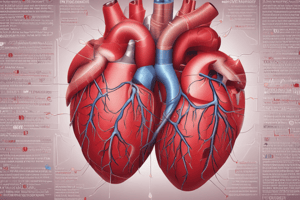Podcast
Questions and Answers
What is the criteria for Stage A heart failure?
What is the criteria for Stage A heart failure?
- Patient has structural heart disease.
- Patient requires specialized interventions.
- Patient has current symptoms of heart disease.
- Patient has high risk for developing left ventricular dysfunction but without structural heart disease or symptoms of heart failure. (correct)
What are the patient characteristics for Stage A heart failure?
What are the patient characteristics for Stage A heart failure?
Hypertension, atherosclerotic disease, diabetes mellitus, metabolic syndrome.
What treatment is recommended for Stage A heart failure?
What treatment is recommended for Stage A heart failure?
- Heart healthy lifestyle. (correct)
- Fluid restriction.
- Beta blockers and statin.
- Diuretics and aldosterone antagonist.
What is the main characteristic of Stage B heart failure?
What is the main characteristic of Stage B heart failure?
What treatments are recommended for Stage B heart failure?
What treatments are recommended for Stage B heart failure?
What are the criteria for Stage C heart failure?
What are the criteria for Stage C heart failure?
What are the patient characteristics for Stage C heart failure?
What are the patient characteristics for Stage C heart failure?
What additional treatments are recommended for Stage C heart failure?
What additional treatments are recommended for Stage C heart failure?
What defines Stage D heart failure?
What defines Stage D heart failure?
What treatments are recommended for Stage D heart failure?
What treatments are recommended for Stage D heart failure?
Flashcards are hidden until you start studying
Study Notes
ACC and AHA Classification of Heart Failure
-
Stage A
- High risk for developing left ventricular dysfunction without structural heart disease or heart failure (HF) symptoms.
- Patient characteristics: Hypertension (HTN), atherosclerotic disease, diabetes mellitus (DM), metabolic syndrome.
- Treatment involves promoting a heart-healthy lifestyle.
- Risk factors include HTN, elevated lipids, DM, and obesity.
-
Stage B
- Characterized by left ventricular dysfunction or structural heart disease without HF symptoms.
- Patient history may include myocardial infarction (MI), left ventricular hypertrophy, and low ejection fraction (EF).
- Treatment includes Stage A interventions, plus the use of ACE inhibitors or ARBs for low EF or history of MI.
- Beta blockers and statins are also recommended.
-
Stage C
- Patients present with left ventricular dysfunction or structural heart disease and current or past symptoms of heart disease.
- Common symptoms include shortness of breath (SOB), fatigue, and decreased exercise tolerance.
- Management expands to include Stage A and B treatments, in addition to diuretics, aldosterone antagonists, sodium restriction, and possibly an implantable defibrillator or cardiac resynchronization therapy.
-
Stage D
- Represents refractory end-stage heart failure requiring specialized interventions.
- Patients experience symptoms despite maximal medical therapy and have recurrent hospitalizations.
- Treatment plan includes all interventions from Stage A, B, and C, along with fluid restrictions, end-of-life care, and extraordinary measures.
- Options may include inotropes, cardiac transplantation, and mechanical support.
Studying That Suits You
Use AI to generate personalized quizzes and flashcards to suit your learning preferences.




